Sludge reduction type activated sludge process
村上定瞭(水浄化フォーラム), Sadaaki Murakami (Water & Solutions Forum)
1. Introduction
2. Classification of sludge substration method
3. Modeling and basic design of sludge reduction system
4. Points for application of sludge reduction type activated process
5. Sludge reduction measures
活性汚泥法の総目次
Ⅰ.活性汚泥法とは
Ⅱ.基本設計・操作因子
Ⅲ.回分型-室内実験
Ⅳ.連続型-室内実験
Ⅴ.活性汚泥の悪化と対策-室内実験
Ⅵ.高酸素濃度型-余剰汚泥なし
Ⅶ.汚泥減量型(本ページ)
Ⅷ.膜分離型-室内実験
Total table of activated sludge process
Ⅰ. What is the activated sludge process?
Ⅱ. Basic design and operation factors
Ⅲ. Batch type – indoor experiment
Ⅳ. Continuous type – indoor experiment
Ⅴ. Deterioration of activated sludge and countermeasures
Ⅵ. High oxygen concentration type – no excess sludge
Ⅶ. Sludge reduction type (this page)
Ⅷ. Membrane separation type – indoor experimrnt
1.はじめに
従来の活性汚泥法に対して,汚泥減量型活性汚泥法は,返送汚泥の一部を処理して基質化し,この基質化汚泥を曝気槽へ返送し生物学的に分解・消化して,排出汚泥を減量化する方法である(図1).
「汚泥の基質化」とは,汚泥を生分解性物質に改質することである。本ページでは、生分解性物質とは、溶解性物質では曝気槽における水理学的滞留時間HRT内で微生物群により分解・消化されるものし、固形物質では処理系内における汚泥滞留時間SRT内で微生物群により分解・消化されるものとする。
1. Introduction
In contrast to the conventional activated sludge method, the sludge reduction type activated sludge process treats some part of the returned sludge to be converted into substances (as substrate to biological organisms) which are then returned to the aeration tank for biological decomposition/digestion. This is an idea to reduce excess sludge (Fig.1).
”Making sludge into substances” means converting the sludge into biodegradable substances. In this idea, the soluble substances from the treated sludge mean that these shall be decomposed and digested by microbial groups within the hydraulic residence time HRT in the aeration tank, and that the solid substances shall be done within the sludge retention time SRT within the treatment system.
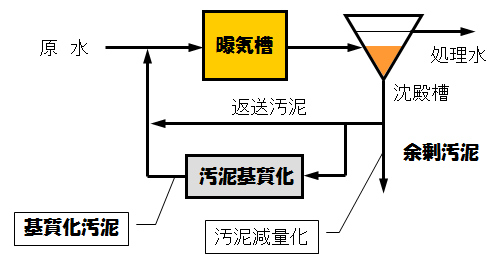
図1 汚泥減量型活性汚泥法のフロー
Fig.1. Flow of activated sludge process with excess sludge reduction.
2.汚泥基質化法の分類
2.1 微生物細胞レベルでの分類
本編集者は汚泥の基質化法を微生物細胞レベルの観点から,1) 細胞殺傷,2) 細胞破砕および 3) 細胞低分子化の3つに分類している(図2).
細胞殺傷法は,化学的または物理的手段により活性汚泥を構成する微生物細胞を損傷・殺傷する方法である.細胞破砕法は,物理的手段により細胞壁を破壊して細胞質を漏出させて,活性汚泥を基質化する方法である.細胞低分子化は,細胞を低分子化・溶解して活性汚泥を基質化する方法である.
2. Classification of sludge substration method
2.1 Classification at the microbial cell level
The editor classifies sludge substration methods from the viewpoint of microbial cell levels into three categories: 1) cell killing, 2) cell crushing, and 3) cell depolymerization (Fig.2).
The cell killing method is a method of damaging or killing the microbial cells that make up the activated sludge by chemical or physical means. The cell disruption method is a method in which the cell wall is destroyed by physical means to leak the cytoplasm and the activated sludge is converted to a substrate. Cell depolymerization is a method of degrading and lysing cells to make activated sludge a soluble substrate.
2.2 基質化装置の方式による分類
提案あるいは開発されている主な汚泥基質化技術をその装置の方式により分類すると,1) 生物法(好熱細菌など),2) 化学法(酸・アルカリ、酸化剤、酵素など),3) 物理法(紫外線、電子線、加熱、マイクロ波、超音波、回転ディスク、高圧噴流など),4) 物理化学法(オゾン、電解塩素、アルカリ加熱、高温高圧法など)に分類できる.
オゾンや電解塩素を用いた方式は,その酸化作用により汚泥を基質化するので化学法に属する.しかし,その設備は放電によるオゾン発生装置や塩化物電解による塩素発生装置を含むので,物理化学法とした.同様な方式に属するものでも,基質化の機構を微生物細胞のレベルで見たとき,その類型は様々に異なる.
2.2 Classification by the type of substration device
The major sludge substration technologies that have been proposed or developed are classified according to the system of the equipment: 1) biological methods (thermophilic bacteria, etc.), 2) chemical methods (acids/alkalis, oxidants, enzymes, etc.), 3) physical methods (ultraviolet rays, electron beams, heating, microwaves, ultrasonic waves, rotating disks, high-pressure jets, etc.), 4) physicochemical methods (ozone, electrolytic chlorine, alkali heating, high temperature and high pressure method, etc.).
The method using ozone or electrolytic chlorine belongs to the chemical method because it converts sludge into a substrate by its oxidizing action. However, since the equipment includes an ozone generator by electric discharge and a chlorine generator by chloride electrolysis, the physicochemical method was adopted. Even if they belong to a similar system, the type of substrate is different when the mechanism of substrate formation is viewed at the level of microbial cells.
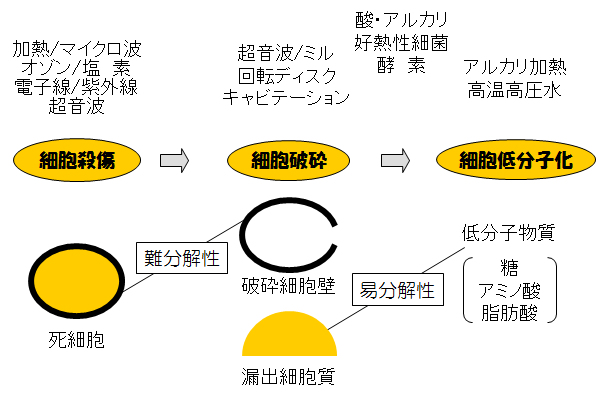
図2 微生物細胞レベルから見た汚泥基質化法の分類
Fig.2. Classification of sludge conversion into substrate from the viewpoint of microbial cell level.
汚泥基質化の具体的な実験法については、逐次、掲載する。
The specific experimental method for converting sludge into a substrate will be posted one by one.
3.汚泥減量化系のモデル化と基本設計
汚水中の有機物(その量はBODで示す)は反応槽内の微生物に摂取され,生命維持のエネルギーとして消費されるとともに,細胞合成(微生物の増殖)に利用される.これを一般式で示すと,汚泥増殖量ΔXまたは増殖率ΔX/Xは,下記の式(1)または式(2)で示される.
ΔX/X = aSr/X – b (2)
ΔX: 汚泥増殖量 [kg/日]
Sr: 除去BOD [kg/日]
X: 反応槽内の微生物量 [kg]
a: 除去BODの汚泥転換率 [-]
b: 内生呼吸による自己分解率 [/日]
ΔX/Xは,好気性微生物と嫌気性微生物では,大きく異なっている.また,同類の微生物でも,負荷量S(容積負荷Γ)と微生物量X(微生物濃度MLSS)または汚泥負荷S/X(Γ/MLSS)によって,ΔX/Xが大きく異なる.泥減量化技術において,ΓやMLSSの設定は汚水浄化システムの設計や操作の重要な因子となる.
表1に,好気性微生物を用いた各種活性汚泥法の操作条件を示す.これらの活性汚泥法に汚泥減量化技術を導入すると,設計条件や操作因子がどのようになるのか,定量的に考察する必要がある.ここでは,汚泥減量型活性汚泥法をモデル化し,本技術の設計・操作の条件について述べる.
3. Modeling and basic design of sludge reduction system
Organic matter in wastewater (the amount of which is indicated by BOD) is taken up by microorganisms in the reaction tank, consumed as energy for life support, and used for cell synthesis (proliferation of microorganisms). If this is expressed by a general formula, the sludge growth amount ΔX or the growth rate ΔX/X is expressed by the following formula (1) or (2).
ΔX/X = aSr/X – b (2)
ΔX: Sludge multiplication [kg/day]
Sr: BOD removed [kg/day]
X: Amount of microorganisms in the reaction tank [kg]
a: Sludge conversion rate of removed BOD [-]
b: Autolysis rate due to endogenous respiration [/day]
ΔX/X differs greatly between aerobic and anaerobic microorganisms. In addition, even for the same type of microorganism, ΔX/X greatly differs depending on the load S (volume load Γ) and the amount of microorganism X (microorganism concentration MLSS) or sludge load S/X (Γ/MLSS). In sludge reduction technology, setting Γ and MLSS is an important factor in the design and operation of wastewater purification systems.
Table 1 shows the operating conditions for various activated sludge processes using aerobic microorganisms. When sludge reduction technology is introduced to these activated sludge processes, it is necessary to quantitatively consider what the design conditions and operating factors will be. Here, the editor models the sludge reduction type activated sludge process and describe the conditions for design and operation of this technology.
Table 1. Operating conditions for various activated sludge.
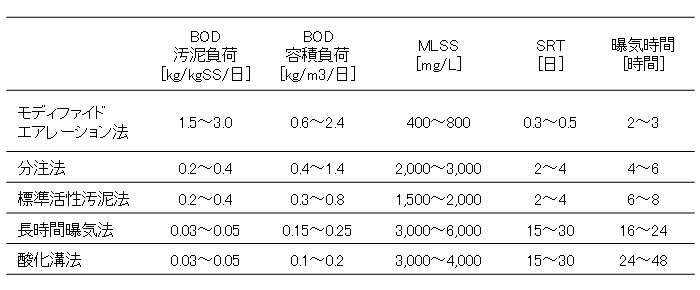
3.1 基質化汚泥の分解・消化過程のモデル化
(1) 活性汚泥を構成する細菌類の細胞構造
活性汚泥の大部分は細菌類が集まったものである.細菌類の細胞は,その外側が細胞壁で包まれている.この細胞壁はペプチドグリカンと呼ばれる多糖の鎖がペプチドの短い鎖によって架橋された複雑な三次元立体構造になっている.グラム陽性菌の細胞壁は,鎖状構造が多いもので40層も重なった三次元的な繊維層を形成し,通常の生物機能による代謝分解は困難かまたはその分解には長い日数を必要とする.
3.1 Modeling of decomposition/digestion process of substrate sludge
(1) Cell structure of bacteria that make up activated sludge
Most of the activated sludge is a group of bacteria. Bacterial cells are surrounded by a cell wall on the outside. This cell wall has a complex three-dimensional structure in which chains of polysaccharides called peptidoglycans are cross-linked by short chains of peptides. The cell wall of Gram-positive bacteria has many chain-like structures and forms a three-dimensional fibrous layer with 40 layers overlapping, and metabolic degradation by normal biological functions is difficult or requires long days for degradation.
(2) 基質化汚泥の分解・消化過程のモデル化
2.1 節において、汚泥基質化法を細胞殺傷,細胞破砕,細胞低分子化に分類した.これらの基質化汚泥の分解・消化過程を速度論的にモデル化して理解することは,汚泥減量型活性汚泥法の設計および運転管理において極めて重要である(図3).
細胞殺傷は,さらに3つ細分類される.1) 基質化処理により細胞が即死t2するものと(即死型),2) 細胞損傷を受けた後,しばらくして細胞死に至るものである(遅死型);τ1(t1~t2).細胞死が起こると,その細胞は,曝気槽内の微生物群の酵素により溶菌(細胞壁の一部が溶解し,細胞質が漏出すること)される;τ2(t2~t3).3) 細胞死が明確でなく,細胞壁が損傷を受けた後,浸透圧による細胞壁の破裂による細胞質の漏出が起こることもある.溶菌や細胞破裂により漏出した細胞質成分は比較的短時間で分解・消化されるものと思われる;τ3(t3~t4).しかし,難生分解性の細胞壁成分は活性汚泥中に混在して,ゆっくりと時間をかけて分解・消化されるもと思われる;τ4(t3~t5).
細胞破砕では,細胞壁が破壊されるので,t3から分解・消化が始まる.
細胞低分子化では,細胞成分は全て低分子されているので,易生分解性となり,その分解・消化過程は短時間(<τ3 )で完了する.
なお、上記したτ1~τ5についは、厳密に観察や測定できるものではなく、そのような課程を経て基質化(殺傷、破砕や低分子化)された汚泥(微生物群)が曝気槽内で分解・消化されるというモデルとして理解することに留意すること.
(2) Modeling of decomposition/digestion process of substrate sludge
In Section 2.1, the sludge substration method was classified into cell killing, cell disruption, and cell depolymerization. It is extremely important to understand the decomposition and digestion mechanism of these substrated sludges by modeling them kinetically in order to design and operate the sludge reduction type activated sludge process (Fig.3).
Cell killing is further subdivided into three categories. 1) Immediate death of cells by substrate treatment t2 (immediate death type), 2) after cell damage, cell death occurs after a while (delayed death type); τ1 (t1 to t2). When cell death occurs, the cells are lysed (a part of the cell wall is lysed and the cytoplasm is leaked) by enzymes of the microbial group in the aeration tank; τ2 (t2 to t3). 3) Cell death is not clear, and after the cell wall is damaged, cell wall rupture due to osmotic pressure may cause cytoplasmic leakage. Cytoplasmic components leaked by lysis or cell rupture are likely to be decomposed and digested in a relatively short time; τ3 (t3 to t4). However, it seems that the biodegradable cell wall components are mixed into the activated sludge floc and slowly decomposed and digested; τ4 (t3 to t5).
In cell disruption, the cell wall is destroyed, so decomposition and digestion start at t3.
In the case of cell depolymerization, all cell components are made into low molecular weight molecules, so they are easily biodegradable and the degradation/digestion process is completed in a short time (< τ3).
Note that the above τ1 to τ5 cannot be observed or measured strictly, and the sludge (microorganism group) that has been converted into a substrate (killed, crushed, or reduced in molecular weight) through such a process is decomposed in the aeration tank. Be aware that you understand as a model of being digested.
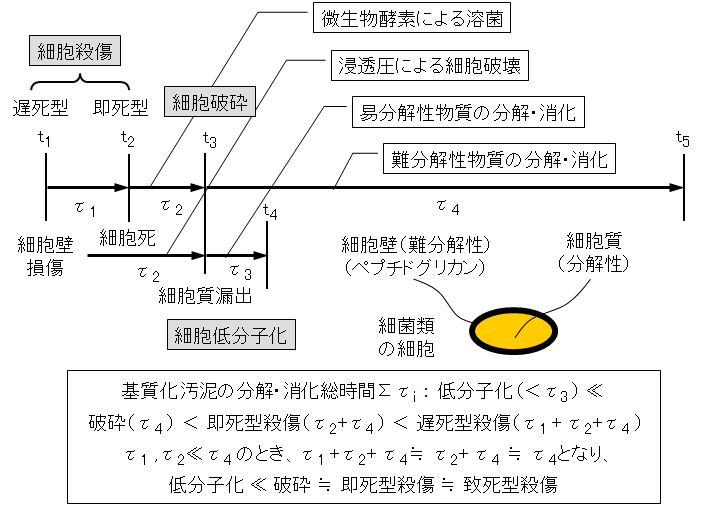
図3 基質化汚泥の分解・消化過程のモデル
Fig.3. Model of decomposition/digestion process of substrate sludge.
(3) 汚泥減量型活性汚泥法のモデル化
図4に示すように,負荷量(基質)S,汚泥総量X,汚泥増殖量ΔX,汚泥滞留日数SRTで運転する従来型活性汚泥法を想定する.この仮想システムでは,基質Sは全て微生物に摂取されるもとし,その内,細胞合成への割合をα(同化率)および生体エネルギー生産への割合をβ(異化率)とする.次に,増殖量ΔXの全量を基質化して曝気槽へ返送する汚泥減量型活性汚泥法を想定する.この仮想系では,返送された基質化汚泥は完全に消化され,系外へ汚泥は全く排出されないものとする.ただし,SRT = X/ΔXは従来型と同じ日数とし,これを減量型(Ⅰ)と略称する.
ΔX/β = a S/β – b X/β (4)
α + β= 1 (5)
α: 基質の同化率 β: 基質の異化率
表2に示すように,培養1日目の増殖量ΔX はαSとなる.2日目にΔXを基質化して返送すると,負荷は(1 + α)Sとなる.以後,これを繰り返すと一定値となり,(1 + α + α2 +・・・)S = S/(1-α) = S/βとなる.同様にして,平衡状態に達したときの曝気槽内の汚泥総量はX/βとなり,増殖式(4)が得られる.
増殖式(4)から、従来型から減量型(Ⅰ)へ移行したときの各操作条件は,従来型の各操作条件に1/βを乗じたものとなる.このような条件では、曝気槽内のMLSSは1/β倍(β< 1)に増加し,沈殿池の能力を超えてしまうことがある.減量型のMLSSを従来型と同じ濃度に維持するためには,どのように運転したらよいかを次に示す.なお,これを減量型(Ⅱ)と略称する.
τ(= STR) = X/ΔX (7)
τ’(= SRT’) = τ/ (1 + bατ) (8)
前節の式(4)に式(5)を代入して変形すると,式(6)が得られる.ただし,式(6)中のτは,式(7)に示すように,従来型におけるSRTである.式(6)より,基質化に必要な汚泥量は,減量型(Ⅱ)では従来型の(1 + bατ) /β倍に増加する.一方,減量型(Ⅱ)の汚泥滞留日数SRT’は式(8)に示すように従来型SRTの1/ (1+ bατ)に短縮される.
(3) Modeling of sludge reduction type activated sludge process
As shown in Fig.4, assume a conventional activated sludge method that operates with load (substrate) S, sludge total amount X, sludge growth amount ΔX, and sludge retention days SRT. In this virtual system, it is assumed that all the substrates S are ingested by microorganisms, of which α (assimilation rate) for cell synthesis and β (catabolic rate) for bioenergy production. Next, a sludge reduction type activated sludge process is assumed, in which all of the growth amount ΔX is converted to a substrate and returned to the aeration tank. In this virtual system, the returned substrated sludge is completely digested and no sludge is discharged outside the system. However, SRT = X/ΔX is the same number of days as the conventional type, and this is abbreviated as the reduction type (I).
ΔX/β = a S/β – b X/β (4)
α + β = 1 (5)
α: Substrate assimilation rate, β: Substrate catabolism rate.
As shown in Table 2, the growth amount ΔX on the first day of culture is αS. When ΔX is converted to a substrate and returned on the second day, the load becomes (1 + α)S. After that, when this is repeated, it becomes a constant value, and (1 + α + α2 +…)S = S/(1-α) = S/β. Similarly, when the equilibrium state is reached, the total amount of sludge in the aeration tank is X/β, and the breeding equation (4) is obtained.
The operating conditions when switching from the conventional type to the reduction type (I) from the multiplication formula (4) are the conventional operating conditions multiplied by 1/β. Under such conditions, the MLSS in the aeration tank may increase 1/β times (β < 1) and exceed the capacity of the settling tank. The following shows how to operate the increasing MLSS to maintain the same concentration as the conventional type. This is abbreviated as the reduction type (II).
τ (= STR) = X/ΔX (7)
τ'(= SRT’) = τ/(1 + bατ) (8)
By substituting Eq.(5) into Eq.(4) in the previous section and transforming it, Eq.(6) is obtained. However, τ in Eq.(6) is the conventional SRT, as shown in Eq.(7). From Eq.(6), the amount of sludge necessary for conversion to substrate increases (1 + bατ) / β times that of the conventional type in the reduction type (II). On the other hand, the sludge retention days SRT’ of the reduction type (II) are shortened to 1/(1+bατ) of the conventional type SRT as shown in Eq.(8).
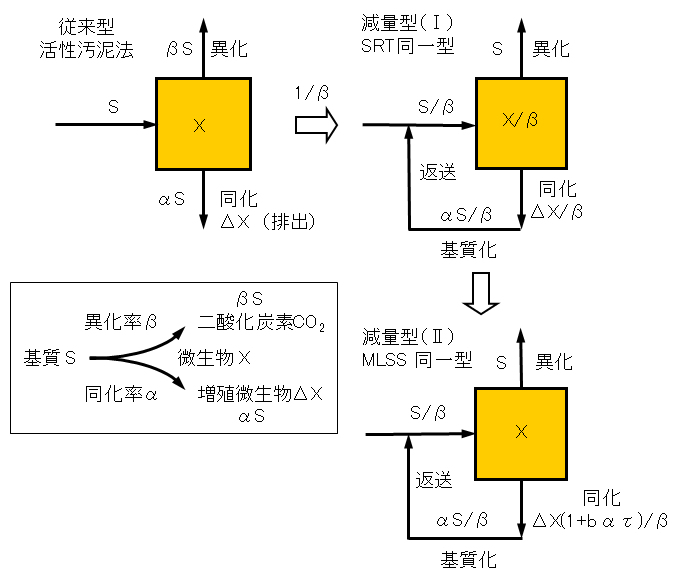
図4 汚泥減量化システムのモデル化
Fig.4. Modeling of sludge reduction system
Table 2. Parameter calculation.
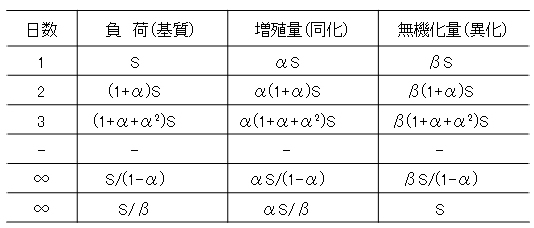
(4) 減量型活性汚泥法の操作因子
表1に示した各種活性汚泥法について,従来型を減量型に変更したとき,その操作因子がどのように変わるか,具体的に計算した結果を表3に示す.また,操作因子の変化をグラフ化したものを図5~図7に示す.汚泥を基質化して曝気槽へ返送することにより,その負荷量および曝気量は,減量型(Ⅰ・Ⅱ)いずれも同化率αの増加とともに増加する.減量型(Ⅱ)の基質化汚泥量は,同化率α、汚泥滞留日数τ、自己分解係数bの増加とともに増加する.
(4) Operating factors of sludge reduction type activated sludge process
Regarding the various activated sludge processes shown in Table 1, when the conventional type is changed to the reduction type (I) or (II), how the operation factor changes will be concretely calculated, and the results are shown in Table 3. In addition, graphs of changes in operating factors are shown in Figs. 5 to 7. By converting sludge into substrates and returning them to the aeration tank, the load and aeration amount increase with increasing assimilation rate α in both the reduction types (I and II). The amount of sludge in the reduction type (II) increases with the increase of assimilation rate α, sludge retention days τ, and autolysis coefficient b.
Table 3. Comparison of operating conditions between conventional and sludge reduction types for activated sludge processes.
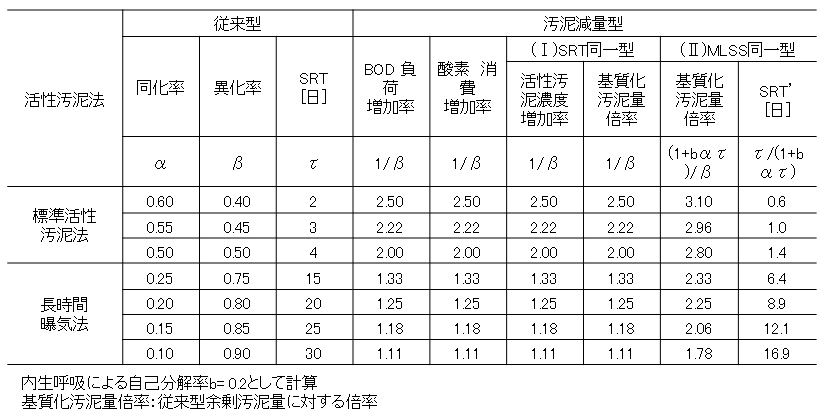
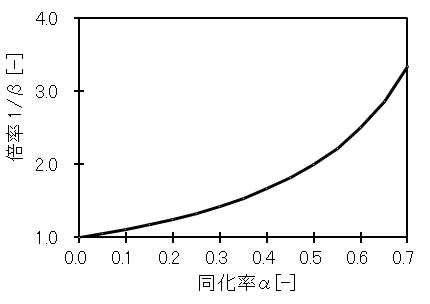
図5 従来型に対する減量型(Ⅰ・Ⅱ)の負荷量・曝気量の増加率および
従来型余剰汚泥量に対する減量型(Ⅰ)の基質化汚泥量の倍率
Fig.5. Increasing rate of load/aeration of the reduction types (ⅠandⅡ) compared to the conventional type, and magnification ratio of the amount of sludge to be substrated in the reduction type (I) to the amount of conventional excess sludge.
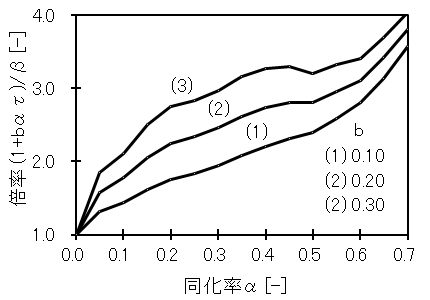
図6 従来型余剰汚泥量に対する減量型(Ⅱ)の
基質化汚泥量の倍率
Fig.6. Magnification ratio of the amount of sludge to be substrated in the reduction type(Ⅱ) to the amount of conventional excess sludge.
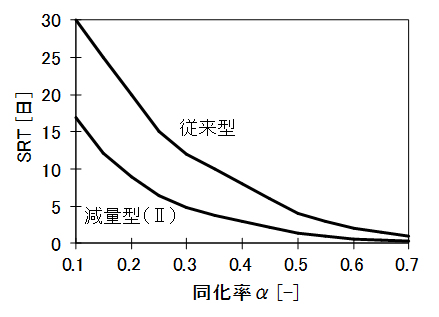
図7 従来型と減量型(Ⅱ)の汚泥滞留日数の比較(b = 0.2 とした)
Fig.7. Comparison of sludge retention days between the conventional type and the sludge reduction type(Ⅱ) (at b = 0.2)
3.2 汚泥減量型活性汚泥法の設計・運転管理
(1) 汚泥減量型の設計・操作の条件
事例として、表4に長時間曝気法(低負荷)および標準活性汚泥法(高負荷)について、汚泥減量型のモデル化から予想される設計・操作の条件を示す。
汚泥減量型を導入すると,SRTを変えない場合には,MLSSが増加する.また,MLSSを従来型と同じに維持すると,活性な微生物の滞留日数SRT’が短縮し,その機能および性状の悪化が予想される.高負荷でSRTの短い活性汚泥法に汚泥減量型を導入すると,異化率βの値が小さいので,BOD負荷の増加率が高く,曝気量の増加率が高くなることが予想される.
3.2 Design and operation management of sludge reduction type activated sludge process
(1) Conditions for design and operation of sludge reduction type
As an example, Table 4 shows the design and operation conditions expected from model of the sludge reduction type for the long-time aeration process (low load and long SRT) and the standard activated sludge process (high load and short SRT).
If the sludge reduction type is introduced, the MLSS increases if the SRT is not changed. If MLSS is maintained at the same level as the conventional type, the retention days SRT’ of active microorganisms will be shortened, and its function and properties are expected to deteriorate. When the sludge reduction type is introduced into the activated sludge process with a high load and a short SRT, the catabolic rate β is small, so the BOD load increase rate and the aeration rate increase rate are expected to increase.
Table 4. Conditions for design and operation of sludge reduction type activated sludge process.
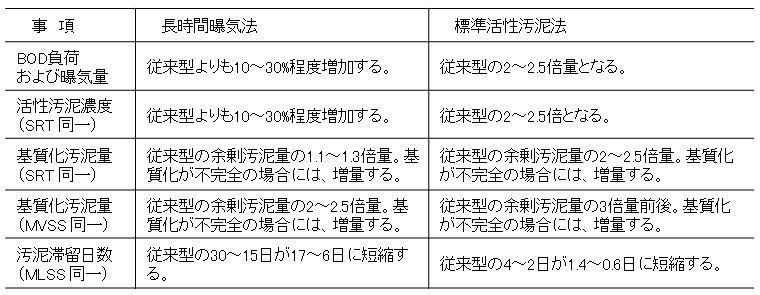
(2) 基質化法の類型と汚泥滞留日数との関係
3.1(2)で述べたように基質化汚泥の分解・消化過程のモデルにおいて,基質化法の類型によりその速度が大きく異なることを示した.また,汚泥減量型の導入によるMLSSの増加を抑えるために,基質化汚泥量を増量する減量型(Ⅱ)では,活性汚泥の滞留日数SRT’が短くなることを示した(表3,表4).SRT’が,図3に示す基質化汚泥の分解・消化総時間Στiより短いと,系内に未消化の難分解性固形物質(主として細胞壁成分)が蓄積して様々な障害を起こすことが予想される.SRT’はΣτiよりも十分長い日数に設定する必要がある.特に,分解・消化に長い日数を必要とする細胞殺傷法や細胞破砕法に属する基質化法には注意を要する.また,基質化設備の運転を開始してから,難生分解性である細胞壁成分などを分解できる微生物群が十分に増殖するまで,数ヶ月の馴致期間が必要である.細胞低分子化法は,分解・消化時間が短いので,SRT’を短く設定できる.
(2) Relationship between types of substrate conversion method and sludge retention days
As described in Section 3.1(2), it was shown that the rate of the decomposition and digestion process of treated sludge greatly differs depending on the type of sludge conversion method. In addition, in order to suppress the increase in MLSS due to the introduction of the sludge reduction type, it was shown that the retention type SRT’ of activated sludge was shortened in the reduction type(Ⅱ) in which the amount of sludge to be treated was increased (Tables 3 and 4). If SRT’ is shorter than the total decomposition/digestion time Στi of the treated sludge shown in Fig.3, it is expected that undigested persistent solid substances (mainly cell wall components) will accumulate in the system and cause various disorders. It is necessary to set SRT’ to a number of days sufficiently longer than Στi. In particular, special attention should be paid to the cell killing method, which requires a long number of days for the decomposition/digestion, and the substration method, which belongs to the cell disruption method. In addition, it takes several months of acclimatization from the start of operation of the substrate conversion equipment to the sufficient proliferation of microorganisms that can decompose the cell wall components which are difficult to be biodegraded. In the cell depolymerization method, the SRT’ can be set short because the decomposition/digestion time is short.
4.Points for application of sludge reduction type activation method
There are some things to keep in mind when changing the existing activated sludge equipment to the sludge reduction type.
4.1 技術上の留意事項
(1) 適用可能なBOD汚泥負荷の限界
既存施設のBOD汚泥負荷は最大0.1kg-BOD/kg-SS/日が限界であろう.これ以上の高負荷で運転している施設の減量型への変更では,曝気量やMLSSの増加が過大となり,曝気装置や汚泥分離槽の増設が必要であろう.
4.1 Technical considerations
(1) Applicable BOD sludge load limit
The maximum load of BOD sludge in the existing facility will be 0.1 kg-BOD/kg-SS/day. If the facility operating at a higher load than this is changed to a reduction type, the aeration amount and MLSS will increase excessively, and it will be necessary to install additional aeration equipment and sludge separation tanks.
(2) 適用可能な汚泥滞留日数
汚泥減量型へ変更するとMLSSが増加し沈殿槽の能力を超えるので,多くの技術では基質化汚泥量は従来法の余剰汚泥量の3倍量としている.このため,汚泥減量型導入後の活性汚泥の滞留日数SRT’は短くなる.特に,細胞殺傷や細胞破砕に属する汚泥基質化法では,細胞壁など難生分解性成分の分解・消化を完全にするために,既存施設のSRTには十分に余裕のある日数が要求される.
(2) Applicable sludge retention days
When switching to the sludge reduction type, MLSS increases and exceeds the capacity of the settling tank, so in many technologies, the amount of substrate sludge is set to three times the amount of excess sludge in the conventional process. Therefore, the retention days SRT’ of activated sludge after introduction of the sludge reduction type becomes short. In particular, in the sludge substration method that belongs to cell killing and cell crushing, the SRT at the existing facility requires a sufficient number of days to completely decompose and digest the components such as cell walls.
(3) 余裕のある汚泥減量化設備の導入
汚泥減量化設備の設計および選定においては,その能力に十分な余裕を持たせる.設備を能力の限界で運転すると,基質化汚泥の分解・消化が不十分となり,目標の汚泥削減率が達成されない.
一般的に削減率は70~80%で設計・運転される。これは、コスト(設備費および運転費)と削減率の関係を最適化したときの値であって,能力に余裕のある設備で運転すると削減率をさらに向上することが可能である.逆に,余裕のない設備で運転すると削減率は低下する.
(3) Introduction of sludge reduction equipment with plenty of room
When designing and selecting the sludge reduction equipment, make sure that there is sufficient margin in its capacity. If the equipment is operated at the limit of its capacity, the decomposition and digestion of the substrate sludge will be insufficient and the target sludge reduction rate will not be achieved.
Generally, the reduction rate is designed and operated at 70 to 80%. This is a value when the relationship between the cost (equipment and operating costs) and the reduction rate is optimized, and it is possible to further improve the reduction rate by operating with equipment with sufficient capacity. On the other hand, the reduction rate decreases when the equipment is operated with no margin.
(4) 処理水質
汚泥減量化システムを導入した場合に処理水のBOD,COD,SSはほとんど変わらないが,TNおよびTPは若干増加する(ただし、窒素・リン除去を導入している施設を除く).
(4) Treated water quality
When the sludge reduction system is introduced, BOD, COD and SS of treated water are almost unchanged, but TN and TP are slightly increased (except for facilities introducing nitrogen/phosphorus removal).
4.2 経済性およびLCA上の留意事項
(1) 経済性
汚泥減量化設備の導入にあたり、経済性についての次に示す①および②の項目について評価する必要があろう。
1) 従来施設の汚泥管理に関する項目:汚泥の発生量とその搬出・運搬・処分などに係る経費
2) 新設備導入に関する項目:新設備および維持管理(人・薬品・電気など)に係る経費
世界の経済情勢、特にエネルギー動向と電気代、国内では人手不足など、その時代の社会状況が変化するので、長期視点による評価が求められる。
4.2 Economical and LCA considerations
(1) Economical
When introducing sludge reduction equipment, it will be necessary to evaluate the following items 1) and 2) regarding economic efficiency.
1) Items related to sludge management in conventional facilities: Amount of sludge generated and expenses related to its removal, transportation, disposal, etc.
2) Items related to the introduction of new equipment: expenses related to new equipment and maintenance (staff, chemicals, electricity, etc.)
As the social situation at the time changes, such as the world economic situation, especially energy trends and electricity bills, and labor shortage in Japan, evaluation from a long-term perspective is required.
(2) LCAなど
新設備の導入に当たって、経済性だけでなく、地域の状況やLCAなどの視点から評価する必要がある。
(2) LCA, etc.
When introducing new equipment, it is necessary to evaluate it not only economically, but also from the perspective of regional conditions and LCA.
5.汚泥減量化対策
5.1 高濃度有機性汚水
高濃度食品製造排水や畜産排水には,汚泥の発生量が少ない嫌気性微生物法が最適であろう.ただし,高濃度の硫黄分を含む排水への適用は難しい.また,嫌気性微生物法では処理水の水質が公共水域への放流基準を満たさず、追加の処理が必要である.仕上げ工程に対しては、汚泥削減化活性汚泥法は有効な手段であろう。
5. Sludge reduction measures
5.1 High-concentration organic wastewater
The anaerobic microbial process, which produces less sludge, would be most suitable for high-concentration food production wastewater and livestock wastewater. However, it is difficult to apply to wastewater containing high concentration of sulfur. In addition, the anaerobic microbial process requires additional treatment because the quality of treated water does not meet the discharge criteria for public water bodies. The sludge reduction type activated sludge process may be an effective means for the finishing process.
5.2 低濃度有機性汚水
生活排水や低濃度有機性産業排水(高濃度排水を希釈する場合を含む。)では,汚泥減量化活性汚泥法の導入が期待できる.ただし,4章で述べたように本法の導入には留意すべき事項がある。
5.2 Low-concentration organic wastewater
For domestic wastewater and low-concentration organic industrial wastewater (including the case of diluting high-concentration wastewater), introduction of the sludge reduction type activated sludge process can be expected. However, as mentioned above in chapter 4, there are some points to be noted when introducing this process.
5.3 大量の汚泥を排出する汚水浄化施設
汚泥を大量に排出する大規模な都市下水や産業排水の浄化施設では,汚泥の減容化(脱水,嫌気性消化,焼却等)や資源化(メタン発酵,堆肥化,炭化,セメント原料化,建設資材化等)を総合的に最適化して,汚泥減量化対策を進めることが大切である.
5.3 Sewage purification facility that discharges a large amount of sludge
In large-scale urban sewage and industrial wastewater purification facilities that discharge large amounts of sludge, it is important to carry out sludge reduction measures by comprehensive optimization of sludge reduction (dehydration, anaerobic digestion, incineration, etc.) and recycling (methane fermentation, composting, carbonization, cement raw material, construction material, etc.)
6.おわりに
微生物を用いた有機性汚水の処理においては、微生物増殖による汚泥が発生する。この汚泥は廃棄物中大きな割合を占め、その処理・処分に高額な経費が費やされている。汚泥減量型活性汚泥法は、汚泥発生量を調節できるので、小規模処理施設を中心に期待される技術である。しかし、この技術の適用にあたっては、いくつかの留意事項がある。汚泥対策にオールマイティはなく,汚水の性状と規模に応じ、減量・減容化と資源化を総合的に最適化した対策が必要であろう。
6. Conclusion
In the treatment of organic wastewater using microorganisms, sludge is generated due to the growth of microorganisms. This sludge occupies a large proportion of the waste, and its treatment and disposal is expensive. The sludge reduction type activated sludge method is a technology expected mainly for small-scale treatment facilities because it can control the amount of sludge generation. However, there are some points to note when applying this technology. There is no almighty measure against sludge, and it is necessary to take measures that comprehensively optimize weight and/or volume reduction of sludge and resource recycling according to the property and scale of wastewater.
掲載:2017年05月31日
更新:2018年10月05日
更新:2020年08月10日(英語版を追加)
Posted: May 31, 2017
Update: October 05, 2018
Update: August 10, 2020 (English version added)
